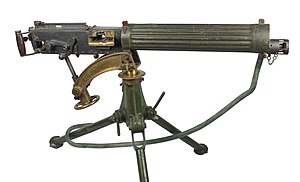| Vickers machine gun | |
|---|---|
 A Vickers machine gun mounted on a tripod. This example is at York Castle Museum. | |
| Type | Heavy machine gun |
| Place of origin | United Kingdom |
| Service history | |
| In service | 1912–1968 |
| Used by | See Users |
| Wars |
|
| Production history | |
| Designed | 1912 |
| Manufacturer | Vickers |
| Unit cost | £175 in 1914,[15] £80 in 1918,[16] ~£50 in 1926[17] |
| Specifications | |
| Mass | 33–51 lb (15–23 kg) all-up |
| Length | 3 ft 8 in (1.12 m) |
| Barrel length | 28 in (720 mm) |
| Crew | 3 |
| Cartridge | .303 British .30-06 Springfield 11mm Vickers others |
| Action | Recoil with gas boost |
| Rate of fire | 450 to 500 round/min |
| Muzzle velocity | 2,440 ft/s (744 m/s) (.303 Mk. VII ball) 2,525 ft/s (770 m/s) (.303 Mk. VIIIz ball) |
| Effective firing range | 2,187 yd (2,000 m) |
| Maximum firing range | 4,500 yd (4,115 m) indirect fire (.303 Mk. VIIIz ball) |
| Feed system | 250-round canvas belt |
The Vickers machine gun or Vickers gun is a water-cooled .303 British (7.7 mm) machine gun produced by Vickers Limited, originally for the British Army. The gun was operated by a three-man crew but typically required more men to move and operate it: one fired, one fed the ammunition, the others helped to carry the weapon, its ammunition, and spare parts.[18] It was in service from before the First World War until the 1960s, with air-cooled versions of it on many Allied World War I fighter aircraft.
The weapon had a reputation for great solidity and reliability. Ian V. Hogg, in Weapons & War Machines, describes an action that took place in August 1916, during which the British 100th Company of the Machine Gun Corps fired their ten Vickers guns to deliver sustained fire for twelve hours. Using 100 barrels, they fired a million rounds without breakdowns. "It was this absolute foolproof reliability which endeared the Vickers to every British soldier who ever fired one. It never broke down; it just kept on firing and came back for more."[19]
- ^ Pegler 2013, p. 5.
- ^ Neeson, Eoin (22 August 2003). "So, once and for all, who did shoot Michael Collins?". The Irish Times.
- ^ Cite error: The named reference
Chacowas invoked but never defined (see the help page). - ^ Cite error: The named reference
Spainwas invoked but never defined (see the help page). - ^ a b c Pegler 2013, p. 49.
- ^ Bloomfield & Leiss 1967, p. 769.
- ^ Cite error: The named reference
Viet Minhwas invoked but never defined (see the help page). - ^ "Arms for freedom". 29 December 2017. Archived from the original on 7 April 2018. Retrieved 31 August 2019.
- ^ Windrow, Martin (1997). The Algerian War, 1954-62. Men-at Arms 312. London: Osprey Publishing. p. 21. ISBN 978-1-85532-658-3.
- ^ Bloomfield & Leiss 1967, p. 854.
- ^ Somasundaram, Jayantha (6 April 2021). "The JVP's Military Battle for Power (The April 1971 Revolt – II)". The Island. Archived from the original on 29 January 2022. Retrieved 28 January 2022.
- ^ Cite error: The named reference
Congowas invoked but never defined (see the help page). - ^ Suciu, Peter (4 May 2021). "The Vickers Gun - Britain's World War Warrior". The Armory Life. Archived from the original on 26 March 2023.
- ^ Footage of weapons which were handed over by rebels to the Syrian Arab Army in Southern Damascus. SyrianCivilWarMap. 12 May 2018. Archived from the original on 1 May 2020. Retrieved 5 September 2021 – via YouTube.
- ^ "Vickers Gun". spartacus-educational.com.
- ^ "MR. KELLAWay's STATEMENT. (Hansard, 24 June 1919)".
- ^ "SIR L. WORTHINGTON-EVANS' STATEMENT. (Hansard, 15 March 1926)".
- ^ [1] Archived 1 April 2012 at the Wayback Machine
- ^ Hogg, Ian V.; Batchelor, John (1976). Weapons & War Machines. London: Phoebus. p. 62. ISBN 978-0-7026-0008-1.
"The Vickers gun accompanied the BEF to France in 1914, and in the years that followed, proved itself to be the most reliable weapon on the battlefield..."